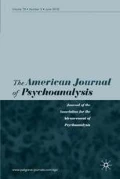Abstract
Ferenczi’s appreciation of the inherently mutual nature of the analytic encounter led him, and many who followed, to explore the value of mutual openness between patient and analyst. Specifically, Ferenczi saw the analyst’s openness as an antidote to his earlier defensive denial of his failings and ambivalence toward the patient, which had undermined his patient’s trust. My own view is that, while the analyst’s openness with the patient can indeed help reestablish trust and restore a productive analytic process in the short term, it also poses long-term dangers. In certain treatments it may encourage “malignant regression”, where the patient primarily seeks gratification from the analyst, resulting in an unmanageable “unending spiral of demands or needs” (Balint, 1968, p. 146). I suggest that an analyst’s “confessions”, in response to the patient’s demand for accountability, can sometimes reinforce the patient’s fantasy that healing comes from what the analyst gives or from turning the tables on his own sense of helplessness and shame by punishing or dominating the analyst. In such situations, the patient’s fantasy may dovetail with the analyst’s implicit theory that healing includes absorbing the patient’s pain and even accepting his hostility, thus confirming the patient’s fantasies, intensifying his malignant regression and dooming the treatment to failure. When malignant regression threatens, the analyst must set firmer boundaries, including limits on her openness, in order to help the patient shift his focus away from expectations of the analyst and toward greater self-reflection. This requires the analyst to resist the roles of rescuer, failure, or victim—roles rooted in the analyst’s own unconscious fantasies.
Similar content being viewed by others
References
Aron, L. (1996). A meeting of minds: Mutuality in psychoanalysis. Hillsdale, NJ: Analytic Press.
Balint, M. (1968). The basic fault: Therapeutic aspects of regression. London: Tavistock.
Benjamin, J. (2009). A relational psychoanalysis perspective on the necessity of acknowledging failure in order to restore the facilitating and containing features of the intersubjective relationship (the shared third). International Journal of Psychoanalysis, 90, 441–450.
Davies, J. M., & Frawley, M. G. (1994). Treating the adult survivor of childhood sexual abuse. New York: Basic Books.
Ehrenberg, D. B. (1992). The intimate edge: Extending the reach of psychoanalytic interaction. New York: W. W. Norton.
Ferenczi, S. (1915). Psychogenic anomalies of voice production. In Further contributions to the theory and technique of psychoanalysis. (pp. 105–109). London: Karnac, 1994.
Ferenczi, S. (1929). The unwelcome child and his death instinct. In Final contributions to the problems and methods of psychoanalysis. (pp. 102–106). London: Karnac, 1994.
Ferenczi, S. (1930). The principles of relaxation and neocatharsis. In Final contributions to the problems and methods of psycho-analysis. (pp. 108–125). London: Karnac, 1994.
Ferenczi, S. (1931). Child-analysis in the analysis of adults. In Final contributions to the problems and methods of psychoanalysis. (pp. 126–142). London: Karnac, 1994.
Ferenczi, S. (1932). The clinical diary of Sandor Ferenczi, J. Dupont (Ed.), M. Balint and N.Z. Jackson (Trans.). Cambridge, MA: Harvard University Press, 1988.
Ferenczi, S. (1933). Confusion of tongues between adults and the child: The language of tenderness and of passion. In Final contributions to the problems and methods of psycho-analysis. (pp. 156–167). London: Karnac, 1994.
Frankel, J. (1993). Collusion and intimacy in the analytic relationship: Ferenczi's legacy. In L. Aron & A. Harris (Eds.), The legacy of Sándor Ferenczi. (pp. 227–248). Hillsdale, NJ: The Analytic Press.
Frankel, J. (1998). The play’s the thing: How the essential processes of therapy are seen most clearly in child therapy. Psychoanalytic Dialogues, 8, 149–182.
Frankel, J. (2002). Exploring Ferenczi’s concept of identification with the aggressor: Its role in trauma, everyday life, and the therapeutic relationship. Psychoanalytic Dialogues, 12, 101–139.
Frankel, J. (2011). Ferenczi’s concepts of identification with the aggressor and play as foundational processes in the analytic relationship. In A. B. Druck, C. S. Ellman, N. Freedman, & A. Thaler (Eds.), A new Freudian synthesis: Clinical process in the new generation (pp. 173–200). London: Karnac.
Frankel, J. (2015). The persistent sense of being bad: The moral dimension of identification with the aggressor. In A. Harris & S. Kuchuck (Eds.), The legacy of Sándor Ferenczi: From ghost to ancestor (pp. 204–222). New York: Routledge.
Frankel, J. (2018). Psychological enslavement through identification with the aggressor. In A. Dimitrijevic, G. Cassullo, & J. Frankel (Eds.), Ferenczi’s influence on contemporary psychoanalytic traditions (pp. 134–139). New York: Routledge.
Garon, J. (2012). From disavowal to murder to liberty. American Journal of Psychoanalysis, 72, 33–45.
Hoffman, I. Z. (1992). Some practical implications of a social-constructivist view of the psychoanalytic situation. Psychoanalytic Dialogues, 2, 287–304.
Hoffman, I. Z. (1996). The intimate and ironic authority of the psychoanalyst’s presence. Psychoanalytic Quarterly, 65, 102–136.
Mucci, C. (2018). Traumatizations of human agency: Why the human bond is essential and what to do in therapy. Paper presented at the International Sándor Ferenczi Conference, Ferenczi in Our Time and a Renaissance of Psychoanalysis, Florence, Italy, May 3–6, 2018.
Nietzsche, F. (1887/2003). The genealogy of morals. Mineola, NY: Dover.
Racker, H. (1968). Transference and countertransference. New York: International Universities Press.
Slochower, J. (1996). Holding and psychoanalysis: A relational perspective. Hillsdale, NJ: The Analytic Press.
Wolstein, B. (1975). Countertransference: The psychoanalyst’s shared experience and inquiry with his patient. Journal of the American Academy of Psychoanalysis, 3, 77–89.
Author information
Authors and Affiliations
Additional information
Jay Frankel, Ph. D., Adjunct Clinical Associate Professor, Clinical Consultant, New York University Postdoctoral Program in Psychotherapy and Psychoanalysis; Faculty, Trauma Studies Program, Manhattan Institute for Psychoanalysis; Associate Editor, Psychoanalytic Dialogues. Author, psychoanalyst in private practice, NYC, USA.
Address correspondence to: Jay Frankel, Ph. D. 300 Mercer Street, Apt. 3L, New York, NY 10003. USA. Email: jbfrankel@gmail.com
Rights and permissions
About this article
Cite this article
Frankel, J. Thoughts on the limits of a mutual technique*. Am J Psychoanal 78, 350–360 (2018). https://doi.org/10.1057/s11231-018-9157-2
Published:
Issue Date:
DOI: https://doi.org/10.1057/s11231-018-9157-2


